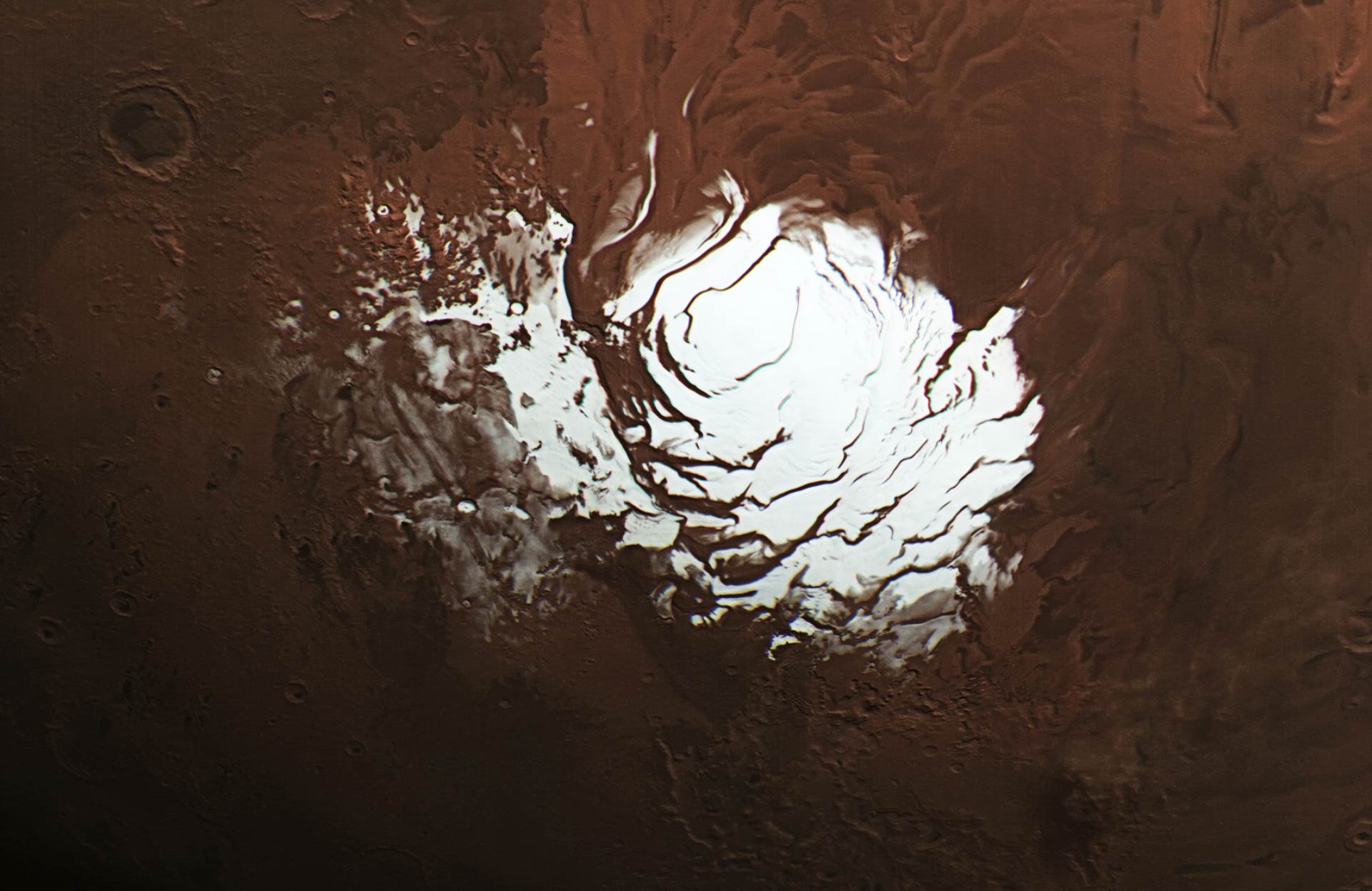Water ice, especially any located in the sub-surface, has long been a focal point of Mars exploration efforts. Reasons abound as to why – from the need to grow plants to the need to create more rocket fuel to blast off the planet for a round trip. Most of that effort has focused on the poles of the planet, where most of the water ice has been found.
Continue reading “Here’s the Best Place for Explorers to Harvest Martian Ice”New Study Says that Martian Weather May Get Snowy Overnight
For decades, scientists have tried to crack the mystery of Mars’ weather patterns. While the planet’s atmosphere is much thinner than our own – with less than 1% of the air pressure that exists on Earth at sea level – clouds have been seen periodically in the skies above the surface. In addition, periodic snowfalls has been spotted over the years, mainly in the form of carbon dioxide snow (i.e. dry ice).
However, according to a new study by a team of French and American astronomers, Mars experiences snowfalls in the form of water-ice particles. These snowfalls occur only at night, coinciding with drops in global temperature. The presence of these storms, and the speed at which they reach the surface, is forcing scientists to rethink Mars’ weather patterns.
The study, titled “Snow Precipitation on Mars Driven by Cloud-Induced Night-Time Convection“, recently appeared in the journal Nature Geosciences. Led by Aymeric Spiga, a tenured lecturer at the Université Pierre et Marie Curie and a researcher at Laboratoire de Météorologie Dynamique in Paris, the team conducted numerical simulations of Mars’ cloudy regions to demonstrate that localized convective snowstorms can occur there.
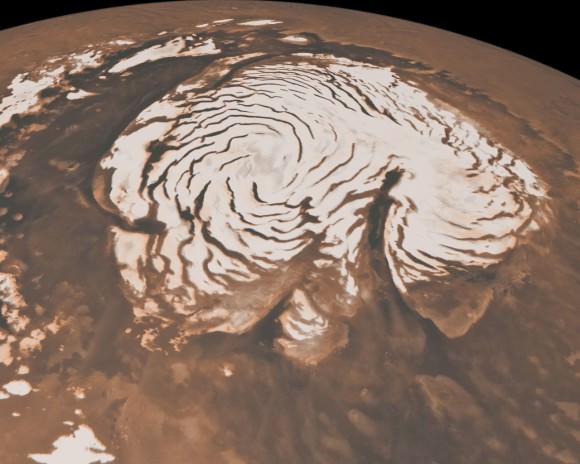
For decades, scientists believed that Mars experienced snowfall in the form of frozen carbon dioxide (aka. dry ice), particularly around the south pole. But it has only been in recent years that direct evidence has been obtained. For instance, on September 29th, 2008, the Phoenix lander took pictures of snow falling from clouds that were 4 km (2.5 mi) above its landing site near the Heimdal Crater.
In 2012, the Mars Reconnaissance Orbiter revealed additional evidence of carbon-dioxide snowfalls on Mars. And there has also been evidence in recent years of low-falling snows, which appear to have helped shape the Martian landscape. These include a relatively young gully fan system in the Promethei Terra region of Mars, which researchers at Brown University determined were shaped by melting snow.
Further, in 2014, data obtained by the ESA’s Mars Express probe showed how the Hellas Basin (a massive crater) was also weathered by melting snows. And in 2015, the Curiosity rover confirmed that the Gale Crater (where it landed in 2012) was once filled by a standing body of water. According to the science team’s findings, this ancient lake received runoff from snow melting on the crater’s northern rim.
All of these findings were rather perlexing to scientists, as Mars was thought to not have a dense enough atmosphere to support this level of condensation. To investigate these meteorological phenomena, Dr. Spiga and his colleagues combined data provided by various Martian lander and orbiter missions to create a new atmospheric model that simulated weather on Mars.
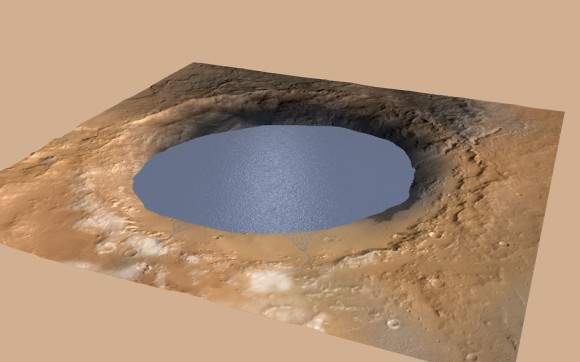
What they found was that during the nights when Mars’ atmosphere became cold enough, water-ice particles could form clouds. These clouds would become unstable and release water-ice precipitation, which fall rapidly to the surface. The team then compared these results to localized weather phenomena on Earth, where cold dense air results in rains or snow falling rapidly from clouds (aka. “microbursts”).
As they state in their study, this information was consistent with data provided by Martian lander and orbiter missions:
“In our simulations, convective snowstorms occur only during the Martian night, and result from atmospheric instability due to radiative cooling of water-ice cloud particles. This triggers strong convective plumes within and below clouds, with fast snow precipitation resulting from the vigorous descending currents.”
The results also contradicted the long-held belief that low-lying clouds would only deposit snow on the surface slowly and gently. This was believed to be the case based on the fact that Mars has a thin atmosphere, and therefore lacks violent winds. But as their simulations showed, water-ice particles that lead to microburst snowstorms would reach the ground within minutes, rather than hours.
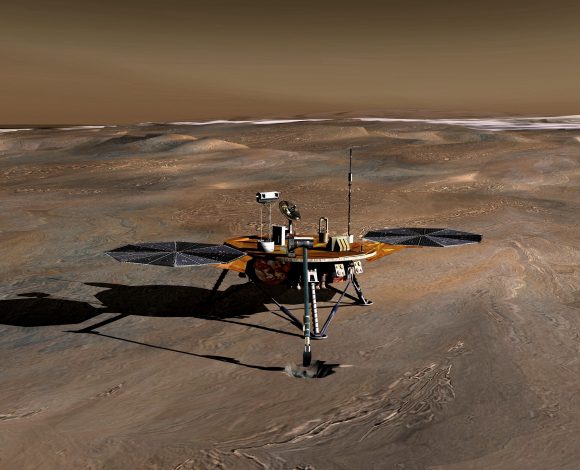
These findings indicate that Martian snowstorms also have a profound influence on the global transport of water vapor and seasonal variations of ice deposits. As they state further:
“Night-time convection in Martian water-ice clouds and the associated snow precipitation lead to transport of water both above and below the mixing layers, and thus would affect Mars’ water cycle past and present, especially under the high-obliquity conditions associated with a more intense water cycle.”
As Aymeric Spiga explained in an interview with the AFP, these snows are not quite what we are used to here on Earth. “It’s not as if you could make a snowman or ski,” he said. “Standing on the surface of Mars you wouldn’t see a thick blanket of snow—more like a generous layer of frost.” Nevertheless, these findings do point towards their being some similarities between the meteorlogical phenomena of Earth and Mars.
With crewed missions to Mars planned for the coming decades – particularly NASA’s “Journey to Mars“, scheduled for the 2030s – it helps to know precisely what kinds of meteorological phenomena our astronauts will encounter. While snowshoes or skis might be out of the question, astronauts could at least look forward to the possibility of seeing fresh snow when they wake up in their habitats!
Further Reading: AFP, Nature Geoscience
Some Active Process is Cracking Open These Faults on Mars. But What is it?
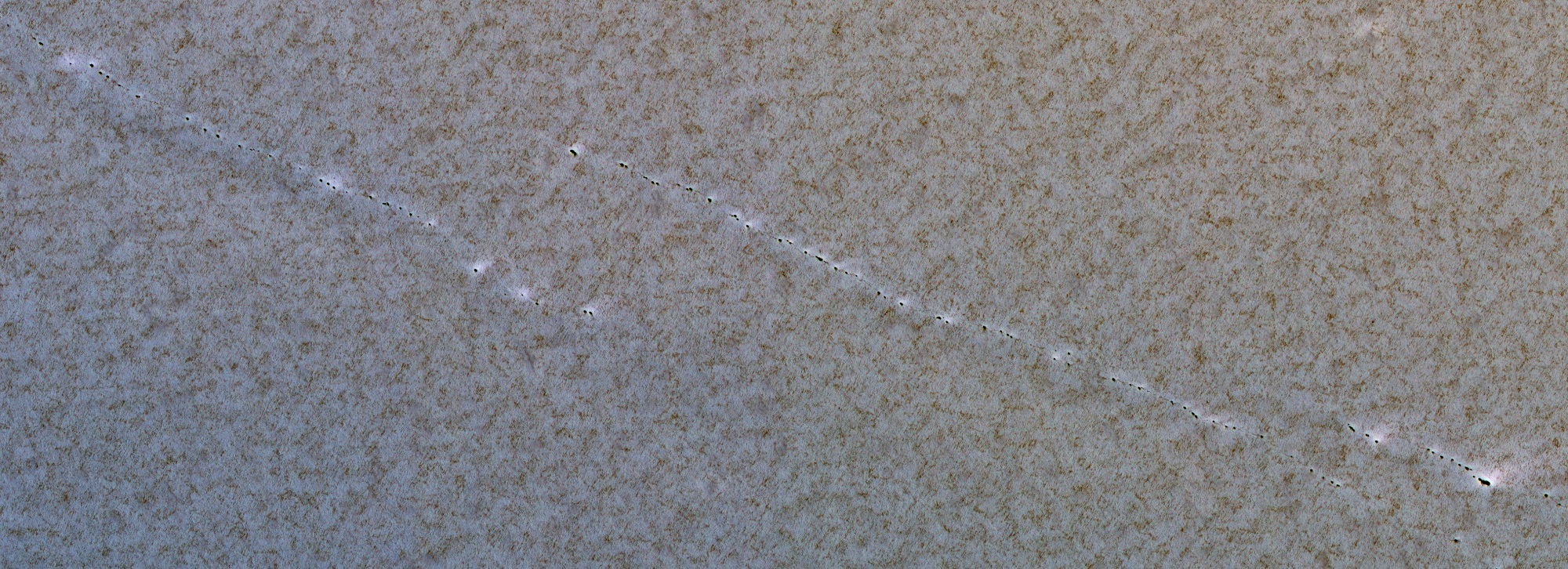
Mars has many characteristics that put one in mind of Earth. Consider its polar ice caps, which are quite similar to the ones in the Arctic and Antarctic circle. But upon closer examination, Mars’ icy polar regions have numerous features that hint at some unusual processes. Consider the northern polar ice cap, which consists predominantly of frozen water ice, but also a seasonal veneer of frozen carbon dioxide (“dry ice”).
Here, ice is arranged in multicolored layers that are due to seasonal change and weather patterns. And as images taken by the Mars Global Surveyor and the Mars Reconnaissance Orbiter (MRO) have shown, the region is also covered in lines of small pits that measure about 1 meter (3.28 feet) in diameter. While these features have been known to scientists for some time, the process behind them remains something of a mystery.
Layered features around found both in the northern and southern polar regions of Mars, and are the result of seasonal melting and the deposition of ice and dust (from Martian dust storms). Both polar caps also show grooves which appear to be influenced by the amount of dust deposited. The more dust there is, the darker the surface of the grooved feature, which affects the level of seasonal melting that takes place.
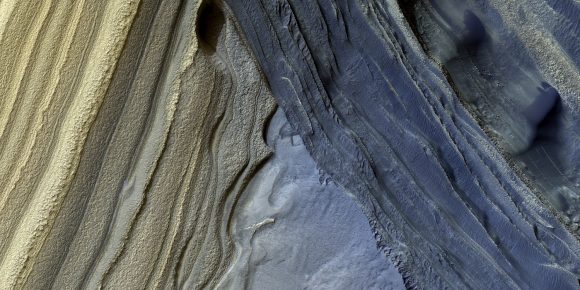
These layered deposits measure around 3-kilometer thick and about 1000 kilometers across. And in many locations, erosion and melting has created scarps and troughs that expose the layering (shown above). However, as NASA’s Mars Global Surveyor revealed through a series of high-resolution images, the northern polar cap also has plenty of pits, cracks, small bumps and knobs that give it a strange, textured look.
These featured have also been imaged in detail by the High Resolution Imaging Science Experiment (HiRISE) instrument aboard the MRO. In 2008, it snapped the image shown at top, which illustrates how the layered features in the northern polar region also have lines of small pits cutting across them. Such small pits should be quickly filled in by seasonal ice and dust, so their existence has been something of a mystery.
What this process could be has been the preoccupation of researchers like Doctor Chris Okubo and Professor Alfred McEwen. In addition to being a planetary geologist from the Lunar and Planetary Laboratory (LPL) at Arizona State University, Prof. McEwen is the Principal Investigator of the High Resolution Imaging Science Experiment (HiRISE).
Dr. Chris Okubo, meanwhile, is a planetary engineer with the LPL who has spent some time examining Mars’ northern polar region, seeking to determine what geological process could account for them. Over time, he also noted that the pits appeared to be enlarging. As he explained to Universe Today via email:
“I monitored some of these pits during northern summer of Mars year 31 (2011-2012). The pits appeared to enlarge over time, starting from depressions roughly centered on the pits observed in in 2008. My interpretation is that these pits are depressions within the residual cap that formed through collapse above a fault or fracture. The pits are buried by seasonal ice in the winter, which then sublimates in the spring/summer leading to an apparent widening and exposure of the pits until they are reburied by seasonal ice in the subsequent winter.”
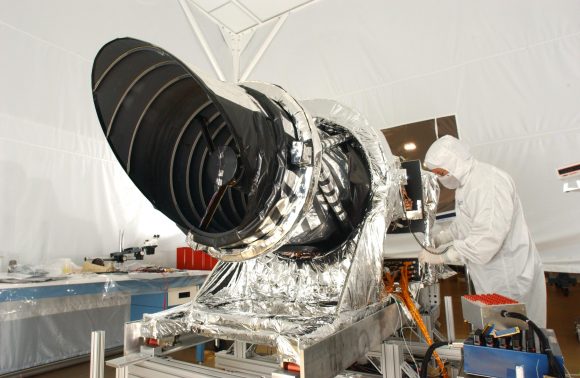
Since the MRO reached Mars in 2006, the LPL has been responsible for processing and interpreting images sent back by its HiRISE instrument. As for these pits, the theory that they are the result of faults pulling apart the icy layers is the most currently-favored one. Naturally, it will have to be tested as more data comes, in showing how seasonal changes play out in Mars’ northern polar region.
“I plan to re-monitor the same pits I looked at in MY31 during this upcoming northern summer to see if this pattern has changed substantially,” said Okubo. “Re-imaging these after several Mars years may also reveal changes to the size/distribution of the pits within the residual cap – if such changes are observed, then that would suggest that the underlying fractures are active.”
One thing is clear though; the layered appearance of Mars polar ice caps and its strange surface features are just another indication of the dynamic processes taking place on Mars. In addition to seasonal change, these interesting features are thought to be related to changes in Mars’ obliquity and axial tilt. Just one more way in which Mars and Earth are similar!
Further Reading: HIRISE
India’s MOM Snaps Spectacular Portrait of New Home – the Red Planet
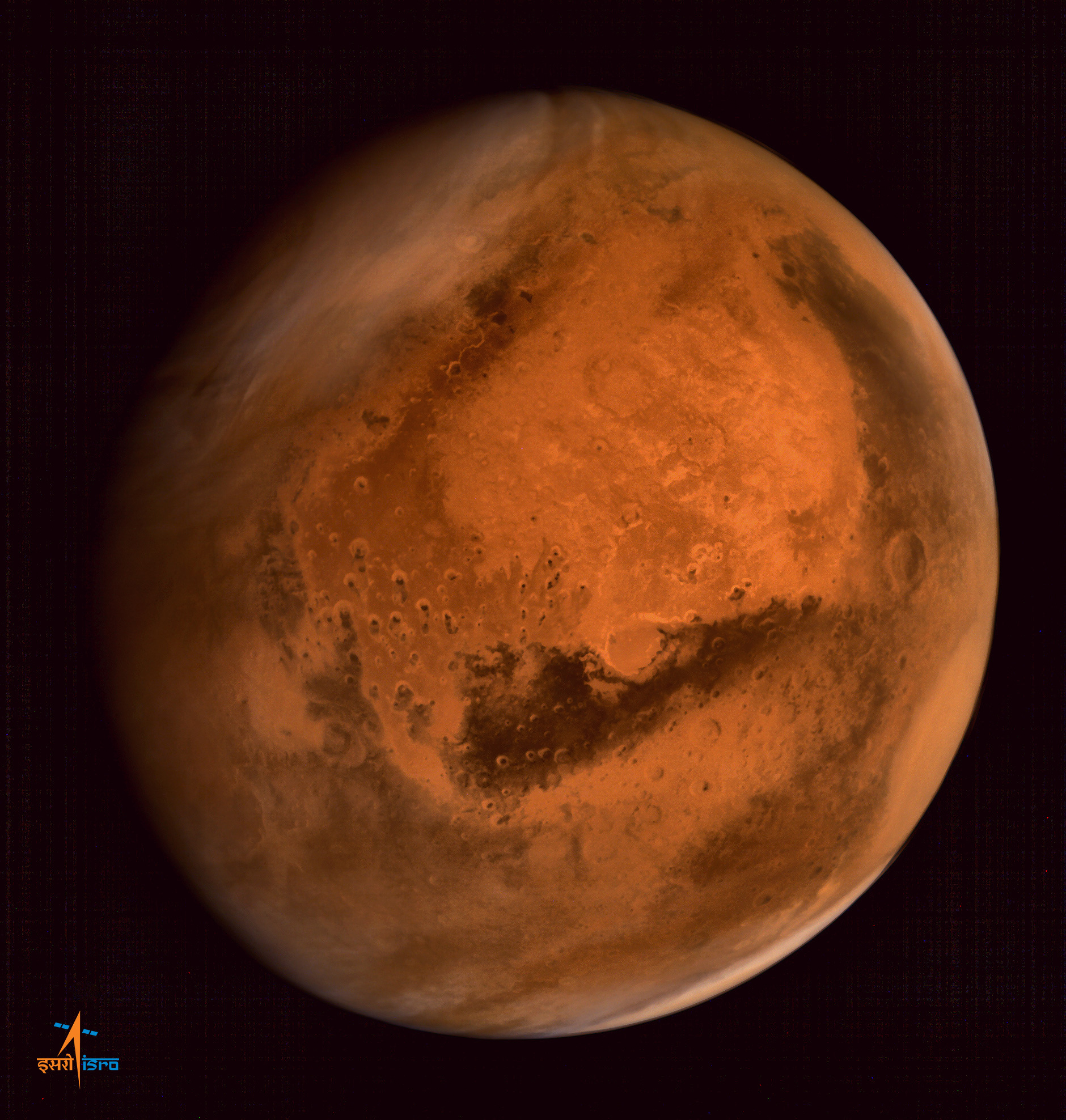
MOM is truly something special.
For her latest eye popping feat, India’s Mars Orbiter Mission (MOM) has snapped the first global portrait of her new Home – the Red Planet.
MOM is India’s first interplanetary voyager and took the stupendous new image on Sept. 28, barely four days after her historic arrival on Sept. 23/24 following the successful Mars Orbital Insertion (MOI) braking maneuver.
The MOM orbiter was designed and developed by the Indian Space Research Organization (ISRO), India’s space agency, which released the image on Sept. 29.
Even more impressive is that MOM’s Martian portrait shows a dramatic view of a huge dust storm swirling over a large patch of the planet’s Northern Hemisphere against the blackness of space. Luckily, NASA’s Opportunity and Curiosity surface rovers are nowhere nearby.
“Something’s brewing here!” ISRO tweeted.
The southern polar ice cap is also clearly visible.
It was taken by the probe’s on-board Mars Color Camera from a very high altitude of 74,500 kilometers.
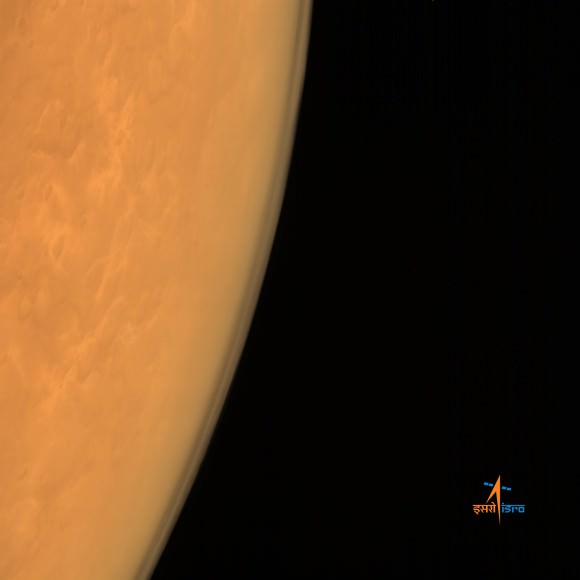
When MOM met Mars, the thrusters placed the probe into a highly elliptical orbit whose nearest point to Mars (periapsis) is at 421.7 km and farthest point (apoapsis) at 76,993.6 km. The inclination of the orbit with respect to the equatorial plane of Mars is 150 degrees, as intended, ISRO reported.
So the Red Planet portrait was captured nearly at apoapsis.
This is the third MOM image released by ISRO thus far, and my personal favorite. And its very reminiscent of whole globe Mars shots taken by Hubble.
MOM’s goal is to study Mars’ atmosphere, surface environments, morphology, and mineralogy with a 15 kg (33 lb) suite of five indigenously built science instruments. It will also sniff for methane, a potential marker for biological activity.
The $73 million mission is expected to last at least six months.
MOM’s success follows closely on the heels of NASA’s MAVEN orbiter which also successfully achieved orbit barely two days earlier on Sept. 21 and could last 10 years or more.
With MOM’s arrival, India became the newest member of an elite club of only four entities who have launched probes that successfully investigated Mars – following the Soviet Union, the United States and the European Space Agency (ESA).
Stay tuned here for Ken’s continuing Earth and planetary science and human spaceflight news.


